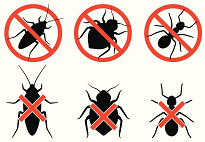Blog
HAVING A REAL CHRISTMAS TREE AND THE PEST PROBLEM |
 HAVING A REAL CHRISTMAS TREE AND THE PEST PROBLEM Having a real Christmas tree in your home is a wonderful thing – there is nothing like the smell of a real tree over an artificial tree. This can be a big decision for many people - fears of introducing unwanted and potentially harmful pests into the home via the tree are unwarranted. Every Christmas tree can be hiding insects, mites, or spiders. Some of these may remain on the tree into winter and could become active after being exposed to the warm temperatures inside the home. Although many will stay on the tree, a few may be attracted to sources of light, including windows. However because most of pests are associated with field-grown trees - most of these accidental introductions are not a threat to your home, its contents, or occupants. Preventing these "pests" into your home is the best, and easiest, plan. Mechanical tree shakers, available at some retail lots, are useful in removing some insects from the trees. You also can vigorously shake the tree before bringing it into your home will serve the same purpose, and will also remove any loose needles. Bird nests, although considered decorative by some people, may contain bird parasites such as mites and lice. They should be removed by hand if not dislodged by shaking. Any egg masses on the trees including those of praying mantis and Gypsy moths should also be removed. Control of these temporary invaders should be limited to non-chemical means. Aerosol insect sprays are flammable and should NOT, under any circumstances, be sprayed on the Christmas tree. Any insects that collect on ceilings, walls, or windows can be eliminated with a vacuum cleaner. It is important to remember that these pests are normally found outdoors, on live trees. Warm temperatures, low humidity and lack of appropriate food conditions typical of most homes will usually kill these invaders in a short time. Most Christmas trees will be free of these bugs. Occasionally, however, one or more of the following may find its way into your home on your tree. Adelgids – mostly found on white pine trees – they are harmless Aphids -most aphids are tiny, inactive, and usually go unnoticed. With their brownish or blackish coloration and long legs, aphids may be mistaken for small spiders or ticks. Aphids, however, have only six legs, while spiders and ticks have eight Bark Beetles -Several species of minute, dark brown to black beetles may be found on or near the tree. They may be boring into the trunk, creating small holes and very fine sawdust. These are bark beetles that were overwintering in the tree. Although they bore into bark or wood, they are not a threat to any of the furnishings or structural parts of the house because wood inside the home is too dry. Mites- many species of predatory mites overwinter as adults and become active when exposed to warm temperatures in the home. They generally remain on the tree, where they may prey on insect and mite eggs. Most of these tiny, light-colored mites will go unnoticed. Scale Insects -overwinter in the egg stage may appear on trees kept indoors long enough for eggs to hatch. The most likely candidate is the pine needle scale. These crawlers could easily be shaken or knocked from the tree. Spiders - In most cases, they will remain on the tree and go unnoticed. But, if they venture off, they may weave small webs on walls, ceilings or furniture. These webs, and their inhabitants, can be removed easily with a vacuum cleaner or dusting brush.
GLOBAL PEST SERVICES in Las Vegas is a licensed pest control company that is qualified to handle all your pest elimination needs. Call our office at 702-657-0091 or go to our web site- to speak with us for all your pest control needs. Get a quote now! Let us know what’s bugging you…
|
FREE QUOTE
Let's Get Started...
Save 20% By Scheduling Online...
Address
 Website Powered by BannerOS. Your Business Energized!
Website Powered by BannerOS. Your Business Energized!





